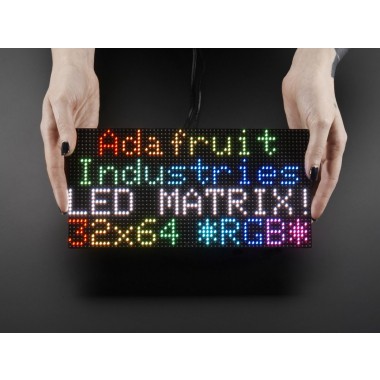Productos
64x32 RGB LED Matrix - 4mm pitch

OFERTA POR RENOVACION DE STOCK!!! Panel con matriz de LEDs RGB de 64x32. La velocidad de scan es de 1:16. Pueden conectarse en cascada y posee base magnética.
COD: D002278
Peso: 0.250 Kg
Disponibilidad: En Stock
ARS 49990.00
El producto no está disponible para la venta en este momento
Características
Bring a little bit of Times Square into your home with this sweet 64 x 32 square RGB LED matrix panel. These panels are normally used to make video walls, here in New York we see them on the sides of busses and bus stops, to display animations or short video clips. We thought they looked really cool so we picked up a few boxes of them from a factory.
This version is the 4mm pitch 64x32 RGB LED Matrix. Please note you cannot use an Arduino UNO to drive this size, its way too big! Use an Arduino Mega, Raspberry Pi, BBB or other device that can handle displaying to RGB matricies and has plenty of RAM.
This matrix has 2048 bright RGB LEDs arranged in a 64x32 grid on the front. On the back there is a PCB with two IDC connectors (one input, one output: in theory you can chain these together) and 12 16-bit latches that allow you to drive the display with a 1:16 scan rate.
These displays are technically 'chainable' - connect one output to the next input - but our Arduino example code does not support this (yet). It requires a high speed processor and more RAM than the Arduino has!
This matrix has 2048 bright RGB LEDs arranged in a 64x32 grid on the front. On the back there are two IDC connectors (one input, one output: in theory you can chain these together) and 12 16-bit latches that allow you to drive the display with a 1:16 scan rate.
These panels require 13 digital pins (6 bit data, 7 bit control) and a good 5V supply, up to 4A per panel. We suggest a 4A regulated 5V adapter and then connecting a 2.1mm jack. Please check out our tutorial for more details!
Comes with:
- A single 64x32 RGB panel,
- An IDC cable
- A plug in power cable
- We also include 4 mounting screws and mini-magnets (it appears these are often mounted on a magnetic base).
Keep in mind that these displays are designed to be driven by FPGAs or other high speed processors: they do not have built in PWM control of any kind. Instead, you're supposed to redraw the screen over and over to 'manually' PWM the whole thing. On a 16 MHz Arduino Mega, we managed to squeeze 12-bit color (4096 colors) with 40% CPU usage but this display would really shine if driven by any FPGA, CPLD, Propeller, XMOS or other high speed multi-core controller. The good news is that the display is pre-white balanced with nice uniformity so if you turn on all the LEDs it's not a particularly tinted white.
Of course, we wouldn't leave you with a datasheet and a "good luck!" We have a full wiring diagrams and working Arduino library code with examples from drawing pixels, lines, rectangles, circles and text. You'll get your color blasting within the hour! On an Arduino, you'll need 16 digital pins, and about 3200 bytes of RAM to buffer the 12-bit color image.
Note: Shipping weight reflects UPS' new dimensional weight regulations.
Technical details
- Dimensions: 255mm x 127mm x 15mm / 10.0” x 5.0” x 0.6”
- Panel weight with IDC cables and power cables: 252.8g
- 5V regulated power input, ~4A max (all LEDs on)
- 1/16 scan rate
- Indoor display, 160 degree visibility
- Displays are 'chainable' - connect one output to the next input - but our Arduino example code does not support this yet





